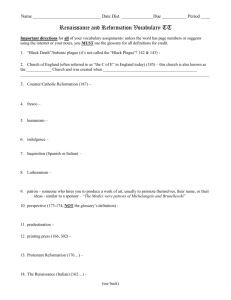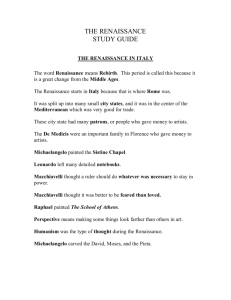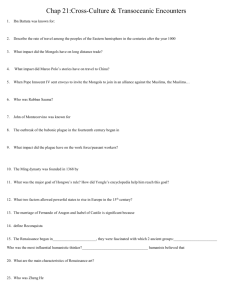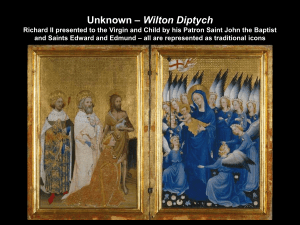17. Renaissance art Culture
advertisement
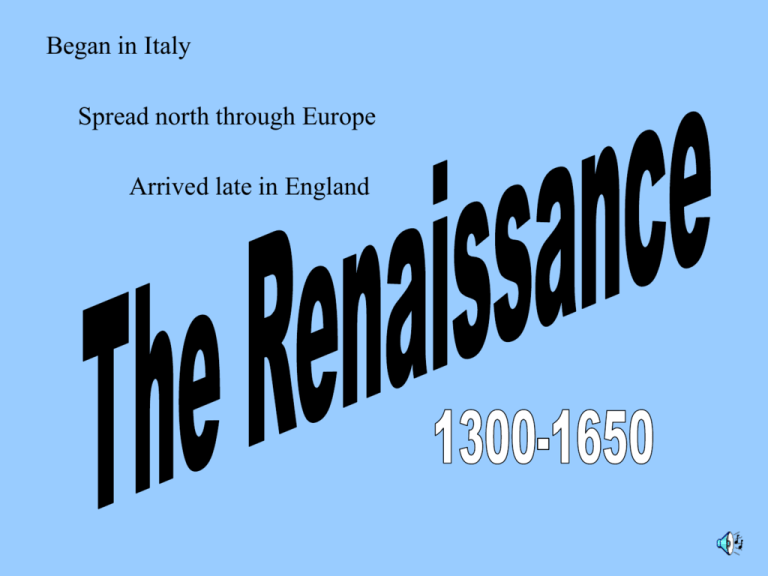
Began in Italy Spread north through Europe Arrived late in England Renaissance = “rebirth” of classical Greek and Roman culture and learning The Renaissance World Small cities and villages Class status and rank important Insecurity – plague, fire, disease In Italian city-states, power given to kings/princes RENAISSANCE HUMANISM •Italian city-states become prosperous trade centers •Wealthy merchants and princes become patrons of the arts •Artists try to compete with great art of classical past •Increased trade demands more educated citizenry •Scholar Francesco Petrarch proposes studia humanitas (liberal arts) modeled after Roman philosopher Cicero Francesco Petrarch 1304-1374 The Increase In Power of Kings Lorenzo de’ Medici 1449-92 called The Magnificent Italian banker and statesman leading patron of arts family ruled Florence for 3 centuries QUEEN ELIZABETH Elizabeth I, daughter of Henry VIII and his second wife Anne Boleyn, ruled England from 1558 to 1603 during what is known as the Elizabethan Age. Elizabeth's reign was a time of great prosperity and achievement, and her court was a center for poets, writers, musicians, and scholars. Focus on grammar, rhetoric, poetry, history, and moral philosophy Return to classical values would create a NEW GOLDEN AGE of culture in city-states Latin language essential to new educational model Recover lost art, wisdom, and culture of the ancient world and build new culture in imitation Optimism about human potential RENAISSANCE MEN --men who are highly accomplished in a variety of endeavors --men with driven, passionate, and compulsive personalities Leonardo da Vinci Michaelangelo --engineering, painting, sculpting, writing, designing, inventing --architect, engineer, painter, sculptor, poet Da Vinci’s masterpiece •Mona Lisa was da Vinci’s favorite painting •He actually took it everywhere he went Mona Lisa 1503-1506 Da Vinci The Last Supper 1495-1497 MICHAELANGELO’S DAVID •1501-1504 •17ft tall •Portrays David waiting to attack Goliath (THE EXPURGATED VERSION) Michaelangelo’s Pieta 1498-1500 Michaelangelo was 25 In St. Peter’s Basilica The Virgin Mary Holding the Dead Christ Pieta means ‘pity’ "It would be impossible for any craftsman or sculptor no matter how brilliant ever to surpass the grace or design of this work, or try to cut and polish the marble with the skill that Michelangelo displayed. For the Pieta was a revelation of all the potentialities and force of the art of sculpture. Among the many beautiful features (including the inspired draperies) this is notably demonstrated by the body of Christ itself. It would be impossible to find a body showing greater mastery of art and possessing more beautiful members, or a nude with more detail in the muscles, veins, and nerves stretched over their framework of bones, or a more deathly corpse. The lovely expression of the head, the harmony in the joints and attachments of the arms, legs, and trunk, and the fine tracery of the veins are all so wonderful that it is hard to believe that the hand of an artist could have executed this inspired and admirable work so perfectly and in so short a time. It is certainly a miracle that a formless block of stone could ever have been reduced to a perfection that nature is scarcely able to create in the flesh." Giorgio Vasari, Lives of the Artists, first published 1550, 2nd edition 1558. Detail of the Pieta— The face of Mary, full of resignation rather than sadness Just days after it was placed in Saint Peter's, Michelangelo overheard a pilgrim remark that the work was done by Christoforo Solari, a compatriot from Lombard. That night in a fit of rage, Michelangelo took hammer and chisel and placed the following inscription on the sash running across Mary's breast in lapidary letters: MICHEL ANGELUS BONAROTUS FLORENT FACIBAT (Michelangelo Buonarroti, Florentine, made this). This is the only work that Michelangelo ever signed. Michelangelo later regretted his passionate outburst of pride and determined to never again sign a work of his hands. MICHAELANGELO’S THE LAST JUDGEMENT 1483-1520 ``While we may term other works paintings, those of Raphael are living things; the flesh palpitates, the breath comes and goes, every organ lives, life pulsates everywhere.'' -- Vasari, Lives of the Artists Raphael’s Christ on the Cross Raphael painted a series of Madonnas including… by Raphael Raphael’s THE SCHOOL OF ATHENS Plato painted to look like da Vinci Aristotletrue renaissance man dabbled in all fields Epicurusdisbelieved in the afterlife, gods do not interfere with men Pythagoras-created famous math thereom Diogenes-the cynical philosopher, searched for honest men with lantern in daylight Red Chalk Drawings were very popular during the Renaissance By Raphael Psyche Offering Venus the Water of Styx Untitled—detail of woman’s face Brueghel – Peasant Wedding Flemish Northern Renaissance painter 1525-1569 Known as Pieter the Elder Father of Jan Brueghel and Pieter the Younger Brueghel’s Tower of Babel Boticelli’s The Birth of Venus Sandro Boticelli c. 1445 - 1510 VENUS AND MARS Madonna of the Magnificat Also by Boticelli Saint Augustine in his Study Donatello (1386?-1466), Italian Renaissance sculptor, who is generally considered one of the greatest sculptors of all time and the founder of modern sculpture. David A self-portrait in sculpture Filippo Brunelleschi 1377-1446 The cupola of The Florence Duomo dedicated to Santa Maria del Fiore Niccolo machiavelli Machiavelli, Niccol (1469-1527), Italian historian, statesman, and political philosopher, whose amoral, but influential writings on statecraft have turned his name into a synonym for cunning and duplicity. Throughout his career Machiavelli sought to establish a state capable of resisting foreign attack. His writings are concerned with the principles on which such a state is founded, and with the means by which they can be implemented and maintained. Author of The Prince Sir Walter Raleigh William Shakespeare Christopher Marlowe Edmund Spenser Born 1564, died 1623 Wrote 38 major plays Performed in the GlobeTheater THE GLOBE THEATER - LONDON Marlowe's plays, such as The Tragical History of Dr. Faustus (1588?) and The Jew of Malta (1589?), are remarkable primarily for their daring depictions of worldshattering characters who strive to go beyond the normal human limitations as the Christian medieval ethos had conceived them. These works are written in a poetic style worthy in many ways of comparison to Shakespeare's. Born in 1564, same year as Shakespeare Dramatic competitor with Shakespeare CHRISTIAN HUMANISTS Focused on programs of practical reform in a wide range of areas, including religion, education, and government Northern Renaissance figures Desiderious Erasmus 1466-1536 •Dutch scholar and reformer •Interested in how to live a pure Christian life •Wrote In Praise of Folly satirizing foolish behavior Sir Thomas More 1478-1535 •English martyr for the Catholic faith •Wrote Utopia, a vision of a perfect world IMPORTANT NEW DISCOVERIES, INNOVATIONS, & CHANGES 1492 Christopher Columbus discovers a new world The World was not what it was assumed to be—anything seemed possible The PROTESTANT REFORMATION MARTIN LUTHER 1483-1546 •On Oct. 31, 1517, nailed 95 theses to the door of Castle Church in Wittenberg, Germany •Upset over abuses of the Catholic church, especially indulgences JOHN CALVIN 1509-1564 •French Protestant reformer based in Geneva, Switzerland •Focus on predestination and the mystery of God’s will Movable Type Printing Press 1 4 5 0 Johannes Guttenberg Availability of Bibles and classic texts fed both the reformation and humanism Advanced educational opportunities Made books cheaper and more widely available THE COPERNICAN REVOLUTION Copernicus 1473-1543 NEW COPERNICAN MODEL OLD PTOLEMAIC MODEL •SUN AT CENTER •EARTH AND MAN AT CENTER OF THE UNIVERSE •EARTH REVOLVES AROUND THE SUN •HEAVENS FLAWED, NOT PERFECT SPHERES •HEAVENS REFLECT PERFECTION OF CREATOR The Plague spread by flea bites carried on rats Renaissance medicine was very primitive—patients were often bled with leeches, superstitious methods of prevention BOCCACCIO ON THE PLAGUE It was not as it had been in the east, where nosebleeds had signaled that death was inevitable. Here the sickness began in both men and women with swelling in the groin and armpits. The lumps varied in size, some reaching the size of an ordinary apple and others that of an egg, and the people commonly called them gavoccioli. Having begun in these two parts of the body, the gavoccioli soon began to appear at random all over the body. After this point the disease started to alter in nature, with black or livid spots appearing on the arms, the thighs, everywhere. Sometimes they were large and well spaced, other times small and numerous. These were a certain sign of impending death, but so was the swelling. The most common form, called bubonic, is characterized by the formation of eggsized swellings at the site of an infected flea bite, usually located in the armpits, groin or neck. Acute agonizing pain accompanies these growths. Next, hemorrhaging under the skin occurs, causing purplish blotches that frequently encircle the waist. Victims of bubonic plague die within four to six days of contraction. A second form, pneumonic, occurs when the infection moves into the lungs, allowing the bacteria to be transmitted easily from person to person. A cough, a sneeze or the mere act of breathing sends death into the air. Symptoms include the vomiting of blood. In septicemia, the third type of plague, massive numbers of the bacilli enter the bloodstream. A victim's body virtually explodes with the disease. A rash appears within hours, and death occurs within a day, even before buboes have time to appear. Whatever form a victim contracted, everything about the plague was disgusting, so that the sick became objects of revulsion rather than of pity. All matter that exuded from their bodies let off an unbearable stench; sweat, excrement, spittle, and breath became so foul as to be overpowering; urine could be turbid, thick, black or red. THE PLAGUE IN ART


